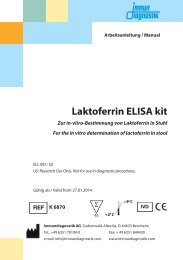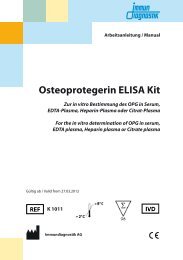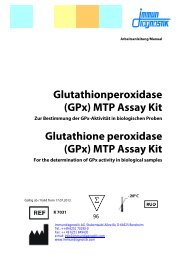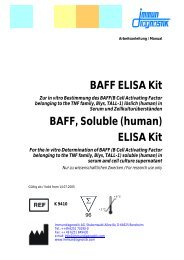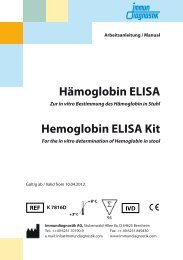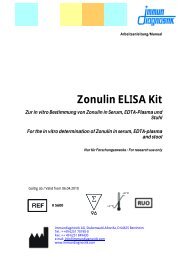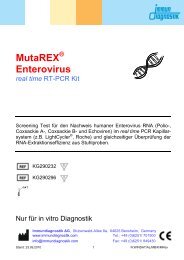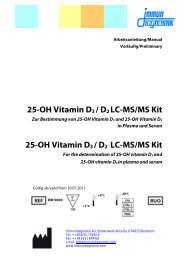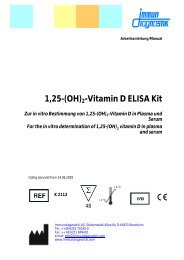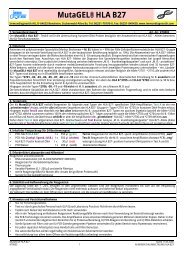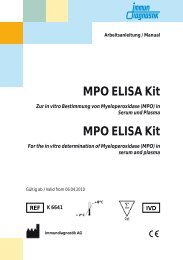Biotin - bei Immundiagnostik
Biotin - bei Immundiagnostik
Biotin - bei Immundiagnostik
Sie wollen auch ein ePaper? Erhöhen Sie die Reichweite Ihrer Titel.
YUMPU macht aus Druck-PDFs automatisch weboptimierte ePaper, die Google liebt.
ifp Institut für Produktqualität GmbH<br />
Teltowkanalstr. 2<br />
12247 Berlin, Germany<br />
www.produktqualitaet.com<br />
Ar<strong>bei</strong>tsanleitung / Manual<br />
ID-Vit® <strong>Biotin</strong><br />
Mikrobiologisches Verfahren zur Bestimmung des<br />
Gesamtgehalts an freiem <strong>Biotin</strong> (Vitamin H ) in Serum mittels einer<br />
Lactobacillus plantarum-beschichteten Mikrotiterplatte<br />
Zur Verwendung in Human- und Veterinärmedizin und zu Forschungszwecken<br />
ID-Vit® <strong>Biotin</strong><br />
Microbiological test kit for the determination of<br />
total free biotin (Vitamin H ) in serum<br />
using a Lactobacillus plantarum coated microtitre plate<br />
For use in human and veterinary medicine and in research<br />
Gültig ab / Valid from 08.03.2012<br />
KIF007<br />
Vertrieb durch/ distributed by:<br />
<strong>Immundiagnostik</strong> AG<br />
Stubenwald-Allee 8a<br />
64625 Bensheim, Germany<br />
www.immundiagnostik.com
Ar<strong>bei</strong>tsanleitung / Manual <strong>Biotin</strong><br />
Inhalt<br />
Content ....................................................................................................................................... 16<br />
1. VERWENDUNGSZWECK ........................................................................................2<br />
2. EINLEITUNG ...........................................................................................................2<br />
3. TESTPRINZIP ..........................................................................................................3<br />
4. INHALT DER TESTPACKUNG ..................................................................................3<br />
5. ERFORDERLICHE LABORGERÄTE UND HILFSMITTEL .........................................4<br />
6. LAGERUNG DER REAGENZIEN ..............................................................................4<br />
7. HINWEISE UND VORSICHTSMASSNAHMEN ........................................................4<br />
8. PROBENVORBEREITUNG .......................................................................................5<br />
8.1. Probenverdünnung ...............................................................................................................5<br />
9. TESTDURCHFÜHRUNG ..........................................................................................6<br />
9.1. Testvorbereitungen ...............................................................................................................6<br />
9.2. Testansatz .................................................................................................................................7<br />
9.3. Messung ....................................................................................................................................8<br />
10. AUSWERTUNG DER ERGEBNISSE .........................................................................8<br />
11. TESTCHARAKTERISTIKA .......................................................................................9<br />
Präzision und Reproduzierbarkeit .............................................................................................. 9<br />
Wiederfindung ................................................................................................................................10<br />
Linearität ............................................................................................................................................12<br />
12. LITERATUR ...........................................................................................................12<br />
13. ALLGEMEINE HINWEISE ZUM TEST ....................................................................13<br />
1
Ar<strong>bei</strong>tsanleitung / Manual <strong>Biotin</strong><br />
1. VERWENDUNGSZWECK<br />
Der ID-Vit® <strong>Biotin</strong> Mikrotiterplattentest ist ein mikrobiologisches Verfahren zur Bestimmung<br />
des Gesamtgehaltes an freiem <strong>Biotin</strong> in Serum. Alle benötigten Reagenzien und der Standard<br />
sind im Test enthalten. Mit dem Test können 96 Bestimmungen incl. der Standards durchgeführt<br />
werden. Für die Auswertung ist ein ELISA-Reader notwendig. Zur Verwendung in Human-<br />
und Veterinärmedizin und zu Forschungszwecken. Nur zur In-vitro-Diagnostik.<br />
2. EINLEITUNG<br />
<strong>Biotin</strong> (Vitamin H) findet sich weit verbreitet in Bakterien, Pilzen, höheren Pflanzen und tierischen<br />
Geweben. In Nahrungsmitteln tritt der Großteil des <strong>Biotin</strong>s kovalent an Protein gebunden<br />
auf, während nur ein geringer Teil in freier Form zur Verfügung steht. Während des Verdauungsvorgangs<br />
wird das Biozytin (<strong>Biotin</strong>yl-Lysin) aus den Proteinen freigesetzt, das ähnlich<br />
dem <strong>Biotin</strong> leicht aus dem Intestinaltrakt resorbiert werden kann. <strong>Biotin</strong> wird anschließend im<br />
Plasma und in den Erythrozyten durch das Einwirken des Enzyms Biozytinase aus dem Biozytin<br />
freigesetzt und steht danach als prosthetische Gruppe für eine Reihe von <strong>Biotin</strong>-abhängigen<br />
Enzymen zur Verfügung.<br />
Der tägliche Bedarf an <strong>Biotin</strong> ist schwer abzuschätzen, da eine gesunde Darmflora durch endogene<br />
Synthese wesentlich zur Deckung des <strong>Biotin</strong>-Bedarfs <strong>bei</strong>trägt. Nach neuesten Erkenntnissen<br />
wird für Erwachsene eine tägliche Zufuhr von 100-200 µg empfohlen. Bei chronischen<br />
Hämodialysepatienten zeigt eine Supplementierung im Milligrammbereich eine deutliche<br />
Verbesserung der neuropathologischen Lage und des Glukosestoffwechsels.<br />
<strong>Biotin</strong>-Mangel<br />
<strong>Biotin</strong>-Mangelerscheinungen werden z. B. durch eine Zerstörung der Darmflora oder durch<br />
extreme Ernährungsgewohnheiten (z.B. häufiger Verzehr von rohen Eiern) verursacht . Folgen<br />
des <strong>Biotin</strong>mangels können sein: Dermatitis, Haarausfall, Anorexie, muskuläre Hypotonie,<br />
Depressionen und Störungen der Fortpflanzung.<br />
Indikationen zum Nachweis eines <strong>Biotin</strong>mangels<br />
� Enzymstörungen (z.B. genetisch defekte <strong>Biotin</strong>idase)<br />
� Veränderte Darmflora<br />
� Fehlernährung<br />
2
Ar<strong>bei</strong>tsanleitung / Manual <strong>Biotin</strong><br />
3. TESTPRINZIP<br />
Das Serum wird verdünnt und in die Kavitäten einer Mikrotiterplatte [PLATE] gegeben, die<br />
mit Lactobacillus plantarum beschichtet sind. Nach Zugabe von <strong>Biotin</strong> als Standard [STD]<br />
oder als in einer Serumprobe enthaltenes Vitamin wächst der Keim solange, bis das Vitamin<br />
aufgebraucht ist. Die Inkubation erfolgt <strong>bei</strong> 37 °C für 48 h. Das Wachstum des Lactobacillus<br />
plantarum wird als Trübung <strong>bei</strong> 610 - 630 nm (alternativ <strong>bei</strong> 540 - 550 nm) im ELISA-Reader<br />
gemessen und mit einer Standard-Konzentrationsreihe verglichen. Die Menge des <strong>Biotin</strong> ist<br />
da<strong>bei</strong> direkt proportional der Trübung.<br />
4. INHALT DER TESTPACKUNG<br />
Artikel Nr. Abkürzung Kit Komponenten Menge<br />
KIF007MTP PLATE<br />
1 x Mikrotiterplatte, beschichtet<br />
mit Lactobacillus plantarum,<br />
gebrauchsfertig<br />
12 Streifen à<br />
8 Kavitäten<br />
KIF007DI DIL Wasser 30 ml, gebrauchsfertig 4 x<br />
KIF007ME ASYMED <strong>Biotin</strong>-Assay-Medium 4 x<br />
KIF007ST STD <strong>Biotin</strong>-Standard 4 x<br />
KIF007FO FOL Abklebefolie 4 x<br />
KIF007FR FRA Ersatzrahmen zum Umstecken<br />
der Mikrotiterstreifen<br />
KIF007KO1 CTRL1 <strong>Biotin</strong>-Kontrolle 1 4 x<br />
KIF007KO2 CTRL2 <strong>Biotin</strong>-Kontrolle 2 4 x<br />
1 x<br />
3
Ar<strong>bei</strong>tsanleitung / Manual <strong>Biotin</strong><br />
5. ERFORDERLICHE LABORGERÄTE UND HILFSMITTEL<br />
4<br />
� Inkubator mit dunkler Inkubationskammer, 37 °C<br />
� Wasserbad (90°C - 100°C)<br />
� ELISA-Reader 610 - 630 nm (540 - 550 nm)<br />
� Mikropipette 20 - 200 µl<br />
� Mikropipette 100 -1000 µl<br />
� Mikropipettenspitzen 20 - 200 µl und 100 -1000 µl, steril<br />
� Pipette 5 bzw. 10 ml<br />
� 1,5 - 2 ml Reaktionsgefäße, steril<br />
� 0,2 µm Polyethersulfon-Sterilfilter und Einwegspritze (10 ml)<br />
� 15 ml Zentrifugenröhrchen, steril (z.B. Falcons)<br />
6. LAGERUNG DER REAGENZIEN<br />
� Den Testkit / die Reagenzien <strong>bei</strong> 2 - 8 °C lagern.<br />
� Angesetzte Reagenzien unmittelbar verwenden und nach Testansatz verwerfen.<br />
� Nicht angebrochene Reagenzien (Standard, Kontrollen, Medium) in den Testkit zurücklegen<br />
und <strong>bei</strong> 2 - 8 °C lagern.<br />
� Nicht benötigte Mikrotiterplatten-Streifen zusammen im Rahmen mit dem Trockenmittel<br />
im Folienbeutel gut verschlossen aufbewahren und <strong>bei</strong> 2- 8 °C lagern. Die Mikrotiterplatten-Streifen<br />
müssen vor Kontamination und Feuchtigkeit geschützt sein.<br />
� Nach Ablauf des Verfallsdatums (siehe Testkit - Außenetikett) kann keine Qualitätsgarantie<br />
mehr übernommen werden.<br />
� Bitte achten Sie <strong>bei</strong> mehrfachem Einsatz der Platte [PLATE] darauf, dass die Reagenzien,<br />
wie in der Vorschrift beschrieben, gelagert und nur die für den jeweiligen<br />
Ansatz benötigten Reagenzienmengen frisch angesetzt werden. Der Kit kann so<br />
bis zu 3 x je nach Probenaufkommen bis zum angegebenen Haltbarkeitsdatum<br />
verwendet werden.<br />
7. HINWEISE UND VORSICHTSMASSNAHMEN<br />
� Es handelt sich um einen mikrobiologischen Test, daher sollten alle Maßnahmen, soweit<br />
möglich, für ein steriles Ar<strong>bei</strong>ten getroffen werden (bevorzugt unter Sterilbank<br />
bzw. PCR-Hood ar<strong>bei</strong>ten, sterile Ar<strong>bei</strong>tsgeräte verwenden).<br />
� Die GLP (Good Laboratory Practice)-Regeln sind <strong>bei</strong> der Testdurchführung einzuhalten.<br />
� Die Wasserqualität ist von großer Bedeutung für den Testablauf. Nur das im Testkit<br />
enthaltene Wasser [DIL] für den Ansatz des Mediums [ASYMED] und die Rekonstitution<br />
des Standards [STD] und der Kontrollen [CTRL1, CTRL2] verwenden.
Ar<strong>bei</strong>tsanleitung / Manual <strong>Biotin</strong><br />
� Bei den Sterilfiltern muss es sich um Polyethersulfon-Sterilfilter handeln.<br />
� Bei jeder Testdurchführung sollte eine Kalibration mitgeführt werden.<br />
� Es wird eine Doppelbestimmung der Standards [STD], der Kontrollen [CTRL1, CTRL2]<br />
und der Proben empfohlen.<br />
� Ergibt die höhere Verdünnung einen höheren Messwert, können Hemmstoffe wie<br />
Antibiotika vorliegen.<br />
� Die Reagenzien dürfen nach Ablauf des Mindesthaltbarkeitsdatums nicht mehr<br />
verwendet werden.<br />
� Während der Testdurchführung Handschuhe tragen.<br />
� Gebrauchte Mikrotiterplattenstreifen sowie andere mit Patientenproben in Kontakt gekommene<br />
Materialien als potenziell infektiös behandeln und entsprechend entsorgen.<br />
� Anzeichen für Reagenzienverfall: Der höchste Standard sollte eine Absorption größer<br />
als 0,6 Extinktionseinheiten (A 630nm > 0,6) erreichen.<br />
8. PROBENVORBEREITUNG<br />
Hinweise<br />
� Als Probe eignet sich Serum.<br />
� Die Haltbarkeit der Probe beträgt <strong>bei</strong> 2 - 8 °C im Dunkeln 3 Tage. <strong>Biotin</strong> an sich ist <strong>bei</strong><br />
2 - 8 °C auch länger haltbar, das Serum jedoch nicht. Deshalb sollte die Probe zur längeren<br />
Lagerung <strong>bei</strong> -20 °C aufbewahrt werden.<br />
� Hämolytische Proben beeinflussen das Testergebnis und sollten nicht verwendet werden.<br />
Lipämische Proben sollten vor dem Einsatz im Test <strong>bei</strong> 13 000 g zentrifugiert werden,<br />
um ein möglichst fettfreies Serum zu erhalten.<br />
� Proben, die sichtbare Mengen an Feststoff (meist Kryoproteine) enthalten, sollten vor<br />
Einsatz zentrifugiert werden (mind. 5 min <strong>bei</strong> 10000 g) und der resultierende Überstand<br />
sollte im Test eingesetzt werden.<br />
8.1. Probenverdünnung<br />
Serumproben und Kontrollen [CTRL1, CTRL2] müssen vor dem Einsatz im Test 1:20 (= Probenverdünnungsfaktor)<br />
mit Wasser [DIL] aus dem Testkit verdünnt werden: 50 µl Probe<br />
+ 950 µl Wasser [DIL]. Sind weitere Verdünnungen notwendig, sollte dies mit Wasser [DIL]<br />
erfolgen.<br />
5
Ar<strong>bei</strong>tsanleitung / Manual <strong>Biotin</strong><br />
9. TESTDURCHFÜHRUNG<br />
6<br />
Hinweise<br />
� Qualitätskontrollen sollten immer mitgemessen werden.<br />
� Inkubationszeit, Temperatur und Pipettiervolumina sind vom Hersteller festgelegt.<br />
Jegliche Abweichung der Testvorschrift, die nicht den Angaben des Herstellers entspricht,<br />
kann zu fehlerhaften Ergebnissen führen.<br />
� Die Bestimmung ist immer nach der im Kit <strong>bei</strong>gefügten Ar<strong>bei</strong>tsanleitung<br />
durchzuführen.<br />
9.1. Testvorbereitungen<br />
Entnehmen Sie die benötigten Reagenzien und Materialien für den durchzuführenden<br />
Test und legen Sie den restlichen Testkit zurück in den Kühlschrank. Bringen Sie die benötigten<br />
Reagenzien auf Raumtemperatur.<br />
Wasser [DIL] für Medium [ASYMED], Standard [STD], Kontrollen [CTRL1, CTRL2] und<br />
Probe<br />
� Alu-Bördelkappe nach oben drücken, nach hinten bis zum Glasrand abziehen und<br />
dann durch Drehen den gesamten Verschluss entfernen.<br />
Assay-Medium [ASYMED]<br />
� Das Medium [ASYMED] muss vor jedem Test frisch hergestellt werden.<br />
� Medium vom Beutel mit Trocknungsmittel in der Mediumflasche mit Hilfe einer sterilen<br />
Pinzette abschütteln. Trockenbeutel herausnehmen und verwerfen.<br />
� Zum Assay-Medium [ASYMED] 10 ml Wasser [DIL] zugeben, das Fläschchen gut verschließen<br />
und schütteln. Die Menge ist ausreichend für 6 Mikrotiterstreifen.<br />
� Mediumflasche [ASYMED] im Wasserbad <strong>bei</strong> 95 °C für 5 min erhitzen; währenddessen<br />
mindestens 2 mal gut schütteln. Es ist darauf zu achten, dass da<strong>bei</strong> die Mediumflasche<br />
[ASYMED] immer fest verschlossen ist.<br />
� Mediumflasche [ASYMED] schnell auf unter 30 °C abkühlen.<br />
� Medium [ASYMED] mit Einwegspritze (10 ml) und einem 0,2 µm-Filter in ein steriles<br />
Zentrifugenröhrchen (15 ml, z.B. Falcon) sterilfiltrieren.<br />
Standard [STD]<br />
Standardverdünnungsreihe vor dem Test frisch herstellen:<br />
� Standardflasche [STD] öffnen, Schraubdeckel mit dem Kopf nach unten ablegen.<br />
� In die Standardflasche [STD] x ml (x = siehe dem Testkit <strong>bei</strong>liegendes QS-Datenblatt)<br />
Wasser [DIL] aus dem Testkit zugeben, mit dem Schraubdeckel verschließen und<br />
schütteln = Standard (Konzentrat).
Ar<strong>bei</strong>tsanleitung / Manual <strong>Biotin</strong><br />
� In 6 sterilen Reaktionsgefäßen (Fassungsvermögen 1,5 - 2,0 ml) Wasser [DIL] aus dem<br />
Testkit vorlegen und anschließend Standard (Konzentrat) hinzupipettieren, d.h. eine<br />
Standardkurve nach folgendem Schema erstellen:<br />
<strong>Biotin</strong><br />
[µg / l]<br />
Wasser [DIL]<br />
[µl] +<br />
Standard [STD]<br />
[µl] =<br />
Gesamtvolumen<br />
[µl]<br />
Blank: 0 500 + 0 = 500<br />
Standard 1: 0,02 450 + 50 = 500<br />
Standard 2: 0,06 350 + 150 = 500<br />
Standard 3: 0,10 250 + 250 = 500<br />
Standard 4: 0,14 150 + 350 = 500<br />
Standard 5: 0,18 50 + 450 = 500<br />
Kontrollen [CTRL1, CTRL2]<br />
Kontrollen vor dem Test frisch herstellen:<br />
� Kontrollflaschen [CTRL1, CTRL2] öffnen, Schraubdeckel mit dem Kopf nach unten ablegen.<br />
� In die Kontrollflaschen [CTRL1, CTRL2] 0.2 ml Wasser [DIL] aus dem Testkit zugeben,<br />
Deckel schließen und Fläschchen vortexten (= Kontrolle 1 und Kontrolle 2).<br />
� Die Kontrollen [CTRL1, CTRL2] werden nach dem Rekonstituieren wie eine Probe behandelt.<br />
� Pro Kavität werden 150 µl der verdünnten Kontrollen [CTRL1, CTRL2] pipettiert. Wir<br />
empfehlen eine Doppelbestimmung der Kontrollen [CTRL1, CTRL2].<br />
� Die Konzentration der Kontrollen [CTRL1, CTRL2] entnehmen Sie bitte der Kontrollspezifikation.<br />
9.2. Testansatz<br />
� Benötigte Mikrotiterstreifen entnehmen und in den Ersatzrahmen [FRA] stecken. Die<br />
nicht gebrauchten Streifen im Rahmen sofort in den Beutel zurücklegen und diesen<br />
sorgfältig verschließen. Die Mikrotiterplatten-Streifen müssen vor Kontamination und<br />
Feuchtigkeit geschützt sein.<br />
7
Ar<strong>bei</strong>tsanleitung / Manual <strong>Biotin</strong><br />
8<br />
� Ein Mediumansatz ist ausreichend für 6 Mikrotiterstreifen (= 48 Kavitäten).<br />
� 150 µl steriles <strong>Biotin</strong>-Assay-Medium [ASYMED] in die Kavitäten geben.<br />
� 150 µl Standard [STD], Kontrollen [CTRL1, CTRL2] bzw. Probe in die jeweiligen Kavitäten<br />
pipettieren. Pipettenspitzen jeweils mit der Standard-, Proben- bzw. Kontrolle-Lösung<br />
vorspülen.<br />
� Sorgfältig die befüllten Kavitäten mit Folie [FOL] abkleben. Wichtig: die Kavitäten<br />
müssen durch Andrücken mit Hand luftdicht verschlossen werden!<br />
� Bei 37 °C für 48 h im Brutschrank inkubieren.<br />
9.3. Messung<br />
� Klebefolie [FOL] nochmals mit der Hand fest andrücken<br />
� Platte [PLATE] über Kopf drehen, auf eine Tischoberfläche legen und Keime gut aufschütteln<br />
� Platte [PLATE] wieder zurückdrehen und Abklebefolie [FOL] diagonal, von unten links<br />
beginnend, 180° nach hinten vorsichtig abziehen. Die Platte da<strong>bei</strong> fixieren.<br />
� Eventuell vorhandene Bläschen an der Oberfläche der Messlösung in den Kavitäten<br />
zerstören, z.B. mit Hilfe einer Pipettenspitze oder einer Nadel<br />
� Trübung im ELISA-Reader <strong>bei</strong> E 610 - 630 nm messen (alternativ <strong>bei</strong> E 540 - 550 nm)<br />
Hinweise<br />
� Nach 48 h Inkubation kann die Mikrotiterplatte [PLATE] auch für max. 48 h im Kühlschrank<br />
aufbewahrt werden, um danach die Trübung zu messen.<br />
� Um Zeitverluste durch Feiertage oder Wochenende zu vermeiden, kann die Mikrotiterplatte<br />
[PLATE] auch noch nach bis zu 60 h Inkubation ausgewertet werden.<br />
10. AUSWERTUNG DER ERGEBNISSE<br />
Wir empfehlen für die Auswertung eine 4-Parameter Funktion. Der Probenverdünnungsfaktor<br />
muss <strong>bei</strong> der Auswertung berücksichtigt werden.<br />
Serum<br />
<strong>Biotin</strong> in µg/l = Wert aus Standardkurve x Probenverdünnungsfaktor
Ar<strong>bei</strong>tsanleitung / Manual <strong>Biotin</strong><br />
Referenzbereich für Humanserum<br />
<strong>Biotin</strong> (n = 84)<br />
< 750 ng/l behandlungsbedürftiger <strong>Biotin</strong>mangel<br />
750 – 1250 ng/l suboptimale <strong>Biotin</strong>versorgung<br />
>1250 ng/l ausreichende <strong>Biotin</strong>versorgung<br />
Anmerkung<br />
Bei einem Probenverdünnungsfaktor von 20 ist ein Bereich von 0,4 - 3,6 µg/l <strong>Biotin</strong> abgedeckt.<br />
Wir empfehlen jedem Labor die Erstellung eines eigenen Normalwerte-Bereichs, weil Referenzbereiche<br />
stark von der Auswahl des Probandenkollektivs abhängig sind. Die Angabe des<br />
Referenzbereichs für <strong>Biotin</strong> dient lediglich der Orientierung und kann von anderen publizierten<br />
Daten abweichen.<br />
11. TESTCHARAKTERISTIKA (mit Humanserum erhoben)<br />
Präzision und Reproduzierbarkeit<br />
Intra-Assay (n=5)<br />
<strong>Biotin</strong> [µg/l] VK [%]<br />
Probe 63.5 3.4<br />
Inter-Assay (n=5)<br />
<strong>Biotin</strong> [µg/l] VK [%]<br />
Probe 64.3 2.9<br />
9
Ar<strong>bei</strong>tsanleitung / Manual <strong>Biotin</strong><br />
Wiederfindung<br />
Proben von 4 Patienten wurden unterschiedlich verdünnt (20, 40, 80, 120, 160), gespiked mit<br />
<strong>Biotin</strong> und analysiert. Die Mittelwerte sind im Folgenden dargestellt:<br />
n = 15<br />
10<br />
Probe<br />
n = 14<br />
Mittelwert der<br />
Originalprobe<br />
[µg/l]<br />
A 1.1<br />
Probe<br />
Mittelwert der<br />
Originalprobe<br />
[µg/l]<br />
B 1.5<br />
Spike<br />
[µg/l]<br />
<strong>Biotin</strong><br />
erwartet<br />
[µg/l]<br />
<strong>Biotin</strong><br />
gemessen<br />
[µg/l]<br />
Wiederfindungsrate<br />
[%]<br />
2 3.1 3.3 110<br />
4 5.1 5.2 103<br />
6 7.1 7.3 103<br />
Spike<br />
[µg/l]<br />
Wiederfindungsrate gesamt [%] 105<br />
<strong>Biotin</strong><br />
erwartet<br />
[µg/l]<br />
<strong>Biotin</strong><br />
gemessen<br />
[µg/l]<br />
Wiederfindungsrate<br />
[%]<br />
2 3.5 3.2 85<br />
4 5.5 4.7 80<br />
6 7.5 7.4 98<br />
Wiederfindungsrate gesamt [%] 88
Ar<strong>bei</strong>tsanleitung / Manual <strong>Biotin</strong><br />
n = 14<br />
Probe<br />
n = 14<br />
Mittelwert der<br />
Originalprobe<br />
[µg/l]<br />
C 1.4<br />
Probe<br />
Mittelwert der<br />
Originalprobe<br />
[µg/l]<br />
D 1.3<br />
Spike<br />
[µg/l]<br />
<strong>Biotin</strong><br />
erwartet<br />
[µg/l]<br />
<strong>Biotin</strong><br />
gemessen<br />
[µg/l]<br />
Wiederfindungsrate<br />
[%]<br />
2 3.4 3.3 95<br />
4 5.4 5.6 105<br />
6 7.4 7.0 93<br />
Spike<br />
[µg/l]<br />
Wiederfindungsrate gesamt [%] 98<br />
<strong>Biotin</strong><br />
erwartet<br />
[µg/l]<br />
<strong>Biotin</strong><br />
gemessen<br />
[µg/l]<br />
Wiederfindungsrate<br />
[%]<br />
2 3.3 3.6 115<br />
4 5.3 5.7 110<br />
6 7.3 6.9 93<br />
Wiederfindungsrate gesamt [%] 106<br />
11
Ar<strong>bei</strong>tsanleitung / Manual <strong>Biotin</strong><br />
12<br />
Linearität<br />
Proben von 2 Patienten wurden verdünnt und analysiert. Die Ergebnisse:<br />
n = 2<br />
Probe Verdünnung<br />
A<br />
C<br />
12. LITERATUR<br />
20<br />
<strong>Biotin</strong> erwartet<br />
[µg/l]<br />
3.0<br />
<strong>Biotin</strong> gemessen<br />
[µg/l]<br />
3.1<br />
40 3.5<br />
80<br />
120<br />
160<br />
20<br />
40<br />
80<br />
Burtis C A, Ashwood E R (Eds): Tietz Textbook of Clinical Chemistry, 3rd Edition, 1999<br />
1.3<br />
3.3<br />
2.9<br />
3.4<br />
1.3<br />
1.3<br />
1.6
Ar<strong>bei</strong>tsanleitung / Manual <strong>Biotin</strong><br />
13. ALLGEMEINE HINWEISE ZUM TEST<br />
� Dieser Kit wurde nach der IVD Richtlinie 98/79/EG hergestellt und in den Verkehr gebracht.<br />
� Sämtliche in der Testpackung enthaltene Reagenzien dürfen ausschließlich zur<br />
Diagnostik in Human- und Veterinärmedizin und zu Forschungszwecken eingesetzt<br />
werden. Nur zur In-vitro-Diagnostik.<br />
� Die Reagenzien sollten nach Ablauf des Verfallsdatums nicht mehr verwendet werden<br />
(Verfallsdatum siehe Testpackung).<br />
� Einzelkomponenten mit unterschiedlichen Lot-Nummern aus verschiedenen Testpackungen<br />
sollten nicht gemischt oder ausgetauscht werden.<br />
� Für die Qualitätskontrolle sind die dafür erstellten Richtlinien für medizinische Laboratorien<br />
zu beachten.<br />
� Die charakteristischen Testdaten wie Pipettiervolumina der verschiedenen Komponenten<br />
und der Aufbereitung der Proben wurden firmenintern festgelegt. Nicht mit<br />
dem Hersteller abgesprochene Veränderungen in der Testdurchführung können die<br />
Resultate beeinflussen. Das ifp Institut für Produktqualität GmbH übernimmt für direkt<br />
daraus resultierende Schäden und Folgeschäden keine Haftung.<br />
Verwendete Symbole:<br />
Temperaturbegrenzung Bestellnummer<br />
In-Vitro-Diagnostikum<br />
Inhalt ausreichend für <br />
Prüfungen<br />
Hersteller Verwendbar bis<br />
Chargenbezeichnung<br />
13
Ar<strong>bei</strong>tsanleitung / Manual <strong>Biotin</strong><br />
14
Ar<strong>bei</strong>tsanleitung / Manual <strong>Biotin</strong><br />
Manual<br />
ID-Vit® <strong>Biotin</strong><br />
Microbiological test kit for the determination of<br />
total free biotin (Vitamin H) in serum<br />
using a Lactobacillus plantarum coated microtitre plate<br />
For use in human and veterinary medicine and in research<br />
Valid from 08.03.2012<br />
KIF007<br />
ifp Institut für Produktqualität GmbH<br />
Teltowkanalstr. 2<br />
12247 Berlin, Germany<br />
www.produktqualitaet.com<br />
Vertrieb durch/ distributed by:<br />
<strong>Immundiagnostik</strong> AG<br />
Stubenwald-Allee 8a<br />
64625 Bensheim, Germany<br />
www.immundiagnostik.com<br />
15
Ar<strong>bei</strong>tsanleitung / Manual <strong>Biotin</strong><br />
Content<br />
1. INTENDED USE .....................................................................................................17<br />
2. INTRODUCTION ...................................................................................................17<br />
3. PRINCIPLE OF THE TEST ......................................................................................17<br />
4. MATERIAL SUPPLIED ...........................................................................................18<br />
5. MATERIAL REQUIRED BUT NOT SUPPLIED ........................................................18<br />
6. PREPARATION AND STORAGE OF REAGENTS ....................................................19<br />
7. PRECAUTIONS .....................................................................................................19<br />
8. SAMPLE PREPARATION .......................................................................................20<br />
16<br />
8.1 Sample dilution .......................................................................................................................20<br />
9. ASSAY PROCEDURE .............................................................................................20<br />
9.1. Test preparations .....................................................................................................................20<br />
9.2. Test Initiation ............................................................................................................................22<br />
9.3. Measurement ...........................................................................................................................22<br />
10. EVALUATION OF RESULTS ...................................................................................23<br />
11. PERFORMANCE CHARACTERISTICS ...................................................................23<br />
Precision and reproducibility .....................................................................................................23<br />
Recovery ............................................................................................................................................24<br />
Linearity .............................................................................................................................................26<br />
12. REFERNECES ........................................................................................................26<br />
13. GENERAL NOTES ON THE TEST AND TEST PROCEDURE ...................................27
Ar<strong>bei</strong>tsanleitung / Manual <strong>Biotin</strong><br />
1. INTENDED USE<br />
ID-Vit® <strong>Biotin</strong> is a microtiter plate test kit based on a microbiological assay which measures<br />
the total free biotin content in serum. The test kit contains all required reagents, e.g. standard,<br />
medium and microtiter plate coated with a specific microorganism, sufficient for 96 determinations<br />
including standard curves. An ELISA reader is required for evaluation of the biotin content.<br />
For use in human and veterinary medicine and in research. For in vitro diagnostic use only.<br />
2. INTRODUCTION<br />
In the late 1950s the discovery of covalently bound biotin with a coenzyme function was<br />
reported. <strong>Biotin</strong> is a growth factor present in minute amounts in every living cell. The fact<br />
that humans have a requirement for biotin has been most clearly shown in 2 situations<br />
that result in biotin deficiency: 1) prolonged consumption of raw egg whites and 2) parenteral<br />
nutrition without biotin supplementation in patients with short-gut syndrome.<br />
<strong>Biotin</strong> plays an indispensable role in numerous naturally occurring carboxylation reactions.<br />
The daily biotin requirements for adults lie between 100 and 200 mg. Renewed interest in the<br />
role of biotin in human nutrition and therapy stems from the accumulating reports of various<br />
biotin-responsive syndromes.<br />
Indications for a determination of biotin<br />
� Defects in enzymes (e.g. genetic deficiency of biotinidase)<br />
� Short gut syndrome<br />
� Malnutrition<br />
3. PRINCIPLE OF THE TEST<br />
Serum samples are diluted and added into the microtiter plate wells coated with Lactobacillus<br />
plantarum which metabolizes biotin. The presence of biotin both in standards<br />
[STD] and samples gives a biotin-dependent growth response. After incubation at 37°C for<br />
48 h, the growth of Lactobacillus plantarum is measured turbidimetrically at 610 - 630 nm<br />
(alternative at 540 - 550 nm) in an ELISA-reader. A dose response curve of absorbance unit<br />
(optical density, OD at 610 nm) vs. concentration is generated using the values obtained from<br />
standard. <strong>Biotin</strong> present in the patient samples is determined directly from this curve.<br />
17
Ar<strong>bei</strong>tsanleitung / Manual <strong>Biotin</strong><br />
4. MATERIAL SUPPLIED<br />
18<br />
Catalog No Label Kit Components Quantity<br />
KIF007MTP PLATE One Lactobacillus plantarum-precoated microtiter<br />
plate, ready to use<br />
12 x 8<br />
wells<br />
KIF007DI DIL Water 30 ml 4 x<br />
KIF007ME ASYMED <strong>Biotin</strong> assay medium 4 x<br />
KIF007ST STD <strong>Biotin</strong> Standard 4 x<br />
KIF007FO FOL Cover plastic foil 4 x<br />
KIF007FR FRA Replacement holder<br />
for 96-well plates<br />
KIF007KO1 CTRL1 <strong>Biotin</strong> Control 1 4 x<br />
KIF007KO2 CTRL2 <strong>Biotin</strong> Control 2 4 x<br />
5. MATERIAL REQUIRED BUT NOT SUPPLIED<br />
� Incubator with a dark incubation chamber, 37 °C<br />
� Water bath (90°C - 100°C)<br />
� ELISA-Reader 610 - 630 nm (540 - 550 nm)<br />
� Micropipette 20 - 200 µl<br />
� Micropipette 100 -1000 µl<br />
� Micropipette tips to deliver 20 - 200 µl and 100 -1000 µl, sterile<br />
� Pipettes of 5 and 10 ml<br />
� 1,5 - 2 ml reaction vials, sterile<br />
� 0,2 µm sterile polyethersulfon filter with a sterile tip<br />
� 15 ml centrifugal tubes, sterile (e.g. Falcon tubes)<br />
1 x
Ar<strong>bei</strong>tsanleitung / Manual <strong>Biotin</strong><br />
6. PREPARATION AND STORAGE OF REAGENTS<br />
� Store test kit / reagents at 2-8°C.<br />
� Prepare reagents freshly and use immediately after preparation. Discard remaining<br />
unused reagents and waste in accordance with country, federal, state, and local regulations.<br />
� Put unused reagents (standard, controls, medium) in the test kit and store at 2-8°C.<br />
� Take as many microtiter strips as needed from kit. Store unused strips in the original<br />
package bag at 2-8° C to prevent contamination or moisture exposure.<br />
� No warranty can be given after the expiry date (see label of test package).<br />
� To run assay more than once, ensure that reagents are stored at conditions stated on<br />
the label. Prepare only the appropriate amount necessary for each assay. The kit can be<br />
used up to 3 times within the expiry date stated on the label.<br />
7. PRECAUTIONS<br />
� As the test is based on a microbiological method, the general guidelines for sterile<br />
work must be observed as far as possible, (work in a sterile bench, PCR-Hood, use of<br />
sterile instruments or equipment).<br />
� Water quality is extremely important. Only the water delivered with the test kit should<br />
be used for medium dilution, standard and control [CTRL1, CTRL2] reconstitution as<br />
well as for sample preparation.<br />
� For sterile filtration, only a sterile polyethersulfone filter must be used.<br />
� It is essential to run a standard curve for each separate assay.<br />
� It is recommended to run a duplicate standard curve as well as a sample analysis.<br />
� If a higher dilution results in a higher measured value, inhibitors like antibiotics might<br />
be present.<br />
� Reagents should not be used beyond the expiration date shown on kit label.<br />
� By finishing the test, the used microtiter plates [PLATE] should be autoclaved.<br />
� Signs for reagent damage: The highest standard should have an absorption higher<br />
than 0.6 Extinktion units (A630nm > 0,6)<br />
19
Ar<strong>bei</strong>tsanleitung / Manual <strong>Biotin</strong><br />
8. SAMPLE PREPARATION<br />
20<br />
Notes<br />
� Patient serum is used for analysis.<br />
� Original samples should be kept light-protected at 2–8°C until measurement. The<br />
samples are stable for 3 days at 2-8°C in the dark. <strong>Biotin</strong> itself can be stored for longer<br />
at 2 - 8 °C, but not the serum. Therefore, samples should be frozen at -20°C for longer<br />
storage.<br />
� Hemolytic samples may give erroneous results and should not be used for analysis.<br />
Lipemic samples should be centrifuged at 13 000 x g before assaying.<br />
� Samples with visible amounts of precipitates should be centrifuged (5 min at 10000 g)<br />
prior to measurement and the resulting supernatant should be used in the test.<br />
8.1 Sample dilution<br />
Serum samples and controls [CTRL1, CTRL2] should be diluted 1:20 (= dilution factor)<br />
with water [DIL] from the kit prior to analysis:<br />
� 50 µl sample + 950 µl water [DIL]<br />
9. ASSAY PROCEDURE<br />
Procedural notes<br />
� Quality control guidelines should be observed.<br />
� Incubation time, incubation temperature and pipetting volumes of the components<br />
are defined by the producer. Any variation of the test procedure, which is not coordinated<br />
with the producer, may influence the results of the test.<br />
� The assay should always be performed according the enclosed manual.<br />
9.1. Test preparations<br />
Take as many microtiter strips as needed from kit. Put unused strips in the original package<br />
bag, and return the remaining parts of the test kit to the refrigerator. Bring all necessary<br />
reagents to room temperature.<br />
Water [DIL] for medium [ASYMED], standard [STD], controls [CTRL1, CTRL2] and<br />
sample<br />
Push the lid up, pull it back to the rim of the glass and then remove the entire seal by<br />
turning.
Ar<strong>bei</strong>tsanleitung / Manual <strong>Biotin</strong><br />
Assay medium [ASYMED]<br />
� The medium must be freshly prepared before the test.<br />
� Take the dry bag out of medium vial [ASYMED] by tweezers, shake off an discard.<br />
� Add 10 ml of water to the assay medium, securely close the bottle and shake well. The<br />
amount is sufficient for 6 strips.<br />
� Heat the bottle with medium in a water-bath at 95 °C for 5 min, while shaking well at<br />
least twice. It is important to make sure that the medium bottle is firmly closed at all<br />
times.<br />
� Quickly cool the medium bottle to under 30 °C.<br />
� Filter the medium sterilely with a 0.2 µm filter in a 15 ml centrifuge test tube.<br />
Standard [STD]<br />
Before the test freshly prepare the standard curve solutions:<br />
� Open the bottle of standard [STD], place the screw-top lid upside-down on the work<br />
bench.<br />
� Add x ml (x = see QS test kit data sheet) water [DIL] from the test kit to the standard<br />
bottle [STD], close the bottle and shake (= standard concentrate).<br />
� Add water [DIL] into 6 sterile reaction vials (capacity 1.5 – 2.0 ml) and then pipet<br />
the standard concentrate to the vials. Prepare a standard curve using the following<br />
scheme:<br />
<strong>Biotin</strong><br />
[µg / l]<br />
Water [DIL]<br />
[µl] +<br />
Standard [STD]<br />
[µl] =<br />
Total volume<br />
[µl]<br />
Blank: 0 500 + 0 = 500<br />
Standard 1: 0,02 450 + 50 = 500<br />
Standard 2: 0,06 350 + 150 = 500<br />
Standard 3: 0,10 250 + 250 = 500<br />
Standard 4: 0,14 150 + 350 = 500<br />
Standard 5: 0,18 50 + 450 = 500<br />
21
Ar<strong>bei</strong>tsanleitung / Manual <strong>Biotin</strong><br />
22<br />
Controls [CTRL1, CTRL2]<br />
� The controls must be freshly prepared before the test.<br />
� Open the bottles of controls [CTRL1, CTRL2], remove seal. Dispose of screw-top lid and<br />
seal.<br />
� Add 0.2 ml water [DIL] from the test kit to the control bottles [CTRL1, CTRL2], close the<br />
bottles and dissolve by vortexing the bottles ( = control 1 and control 2).<br />
� Treat the control afterwards as the sample is treated.<br />
� Pipette 150 µl of the reconstituted controls [CTRL1, CTRL2] into each well. We recommend<br />
to run a duplicate.<br />
� For the concentration of the controls [CTRL1, CTRL2] please see Control specification.<br />
9.2. Test Initiation<br />
� Take as many microtiter strips as needed from the kit in put them in the second<br />
microtiter strip holder [FRA]. Store unused strips in the original package bag at 2-8° C<br />
to prevent contamination or moisture exposure.<br />
� A medium solution is sufficient for 6 strips.<br />
� Put 150 µl biotin assay medium [ASYMED] in the cavities.<br />
� Add 150 µl standard [STD], controls [CTRL1, CTRL2], respectively, sample in the cavities.<br />
Pre-rinse the pipette tip with standard, control and sample solution respectively.<br />
� Carefully seal the cavities with plastic foil [FOL]. Important: the cavities must be made<br />
airtight by pressing down with the hand!<br />
� Keep at 37 °C for 48 hrs in an incubator.<br />
9.3. Measurement<br />
� Securely press the foil [FOL] down with the hand.<br />
� Upturn the plate [PLATE] onto a tabletop and shake the germination well.<br />
� Turn the plate over again and carefully remove the foil [FOL], beginning with the<br />
lower, left corner and pulling diagonally backwards at an angle of 180°.<br />
� Remove air bubbles in the cavities using a pipette tip or a needle.<br />
� Read turbidity in an ELISA-Reader at E 610 - 630 nm (alternatively at 540 - 550 nm)<br />
Please note<br />
� After 48 hrs incubation time, the microtiter platter may be stored for a maximum of<br />
48 hrs in the refrigerator before measuring the turbidity.<br />
� To prevent time-loss through public holidays or weekends, the microtiter plate may<br />
also be evaluated after 60 hrs incubation.
Ar<strong>bei</strong>tsanleitung / Manual <strong>Biotin</strong><br />
10. EVALUATION OF RESULTS<br />
We recommend to use the 4-Parameter-algorithm to calculate the results. The sample dilution<br />
factor should be considered for data evaluation.<br />
Serum<br />
<strong>Biotin</strong> in µg/l = Value from the standard curve x dilution factor<br />
Reference value for human serum<br />
<strong>Biotin</strong> (n = 84)<br />
< 750 ng/l biotin deficiency requiring treatment<br />
750 – 1250 ng/l suboptimal biotin status<br />
>1250 ng/l sufficient levels of biotin<br />
Please note: A concentration range of 0.4 - 3.6 µg/L biotin is covered at a sample dilution 1: 20.<br />
We recommend each laboratory to develop its own normal range. The values mentioned above<br />
are only for orientation and can deviate from other published data.<br />
11. PERFORMANCE CHARACTERISTICS (obtained using human serum)<br />
Precision and reproducibility<br />
Intra-Assay (n=5)<br />
<strong>Biotin</strong> [µg/l] CV [%]<br />
Sample 63.5 3.4<br />
Inter-Assay (n=5)<br />
<strong>Biotin</strong> [µg/l] CV [%]<br />
Sample 64.3 2.9<br />
23
Ar<strong>bei</strong>tsanleitung / Manual <strong>Biotin</strong><br />
Recovery<br />
Samples from 4 patients were diluted differently (20, 40, 80, 120, 160), spiked with <strong>Biotin</strong> and analyzed.<br />
The mean values are shown below:<br />
n = 15<br />
24<br />
Sample<br />
n = 14<br />
Mean value<br />
measured in<br />
original sample<br />
[µg/L]<br />
A 1.1<br />
Sample<br />
Mean value<br />
measured in<br />
original sample<br />
[µg/L]<br />
B 1.5<br />
Spike<br />
[µg/L]<br />
<strong>Biotin</strong><br />
expected<br />
[µg/L]<br />
<strong>Biotin</strong><br />
measured<br />
[µg/L]<br />
Recovery<br />
Rate [%]<br />
2 3.1 3.3 110<br />
4 5.1 5.2 103<br />
6 7.1 7.3 103<br />
Spike<br />
[µg/L]<br />
Recovery rate in total [%] 105<br />
<strong>Biotin</strong><br />
expected<br />
[µg/L]<br />
<strong>Biotin</strong> measured<br />
[µg/L]<br />
Recovery<br />
Rate<br />
[%]<br />
2 3.5 3.2 85<br />
4 5.5 4.7 80<br />
6 7.5 7.4 98<br />
Recovery rate in total [%] 88
Ar<strong>bei</strong>tsanleitung / Manual <strong>Biotin</strong><br />
n = 14<br />
Sample<br />
n = 14<br />
Mean value<br />
measured in<br />
original sample<br />
[µg/L]<br />
C 1.4<br />
Sample<br />
Mean value<br />
measured in<br />
original sample<br />
[µg/L]<br />
D 1.3<br />
Spike<br />
[µg/L]<br />
<strong>Biotin</strong><br />
expected<br />
[µg/L]<br />
<strong>Biotin</strong><br />
measured<br />
[µg/L]<br />
Recovery<br />
Rate<br />
[%]<br />
2 3.4 3.3 95<br />
4 5.4 5.6 105<br />
6 7.4 7.0 93<br />
Spike<br />
[µg/L]<br />
Recovery rate in total [%] 98<br />
<strong>Biotin</strong><br />
expected<br />
[µg/L]<br />
<strong>Biotin</strong><br />
measured<br />
[µg/L]<br />
Recovery<br />
Rate<br />
[%]<br />
2 3.3 3.6 115<br />
4 5.3 5.7 110<br />
6 7.3 6.9 93<br />
Recovery rate in total [%] 106<br />
25
Ar<strong>bei</strong>tsanleitung / Manual <strong>Biotin</strong><br />
Linearity<br />
Two patient samples were diluted and analyzed. The results are shown below:<br />
n = 2<br />
26<br />
Sample Dilution<br />
A<br />
C<br />
12. REFERENCES<br />
20<br />
Expected<br />
[µg/L]<br />
3.0<br />
Measured<br />
[µg/L]<br />
3.1<br />
40 3.5<br />
80<br />
120<br />
160<br />
20<br />
40<br />
80<br />
Burtis C A, Ashwood E R (Eds): Tietz Textbook of Clinical Chemistry, 3rd Edition, 1999<br />
Coronel F et al. (1991) Treatment of hyperlipemia in diabetic patients on dialysis with a physiological<br />
substance. Am J Nephrol 11(1):32-6<br />
1.3<br />
3.3<br />
2.9<br />
3.4<br />
1.3<br />
1.3<br />
1.6
Ar<strong>bei</strong>tsanleitung / Manual <strong>Biotin</strong><br />
13. GENERAL NOTES ON THE TEST AND TEST PROCEDURE<br />
� This assay was produced and put on the market according to the IVD guidelines of<br />
98/79/EC.<br />
� Test components contain organic solvents. Contact with skin or mucous membranes<br />
must be avoided.<br />
� All reagents in the test package are for use in human and veterinary medicine and in<br />
research. For in vitro diagnostic use only.<br />
� Reagents should not be used after the date of expiry stated on the label.<br />
� Single components with different lot numbers should not be mixed or exchanged.<br />
� Guidelines for medical laboratories should be observed.<br />
� Incubation time, incubation temperature and pipetting volumes of the different<br />
components are defined by the producer. Any variations of the test procedure that are<br />
not coordinated with the producer may influence the results of the test. ifp Institute<br />
for Product Quality GmbH can, therefore, not be held reliable for any damage resulting<br />
from this.<br />
Used symbols:<br />
Temperature limitation Catalogue Number<br />
In Vitro Diagnostic Medical Device Contains sufficient for tests<br />
Manufacturer Use by<br />
Lot number<br />
27
<strong>Immundiagnostik</strong> AG<br />
Stubenwald-Allee 8a<br />
D-64625 Bensheim<br />
Tel.: +49 (0) 62 51/70 19 00<br />
Fax: +49 (0) 62 51/84 94 30<br />
info@immundiagnostik.com<br />
www.immundiagnostik.com



